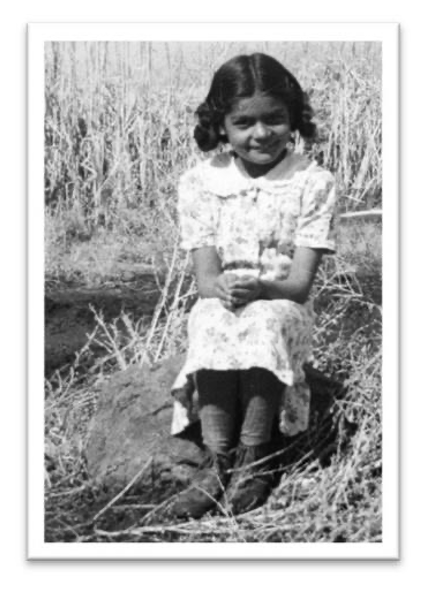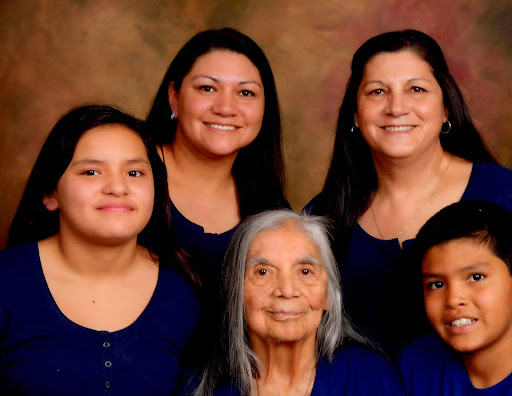Overview
Carmelita Evans DeLucchi: Preserving Wel-mel-ti Culture and Traditions Through Oral History

Authors: Kellie Harry (Pyramid Lake Paiute Tribe member, Wel-mel-ti Washoe descendant) and Jesse Blackburn
Lesson partner: Rebecca Lowry, Humboldt County Office of Education
Honoring Our Ancestors: Sierra Valley Wel-mel-ti Unit (Lesson 1 of 3)
Lesson 1 - Carmelita Evans DeLucchi: Preserving Wel-mel-ti Culture and Traditions Through Oral History
Lesson 2 - Marvin Sam: Changes for Land Mean Changes for Traditional Foods
Lesson 3 – Wilbur Smith: Wel-mel-ti Values Across Places, Cultures, and Changes
Grade: 2

Suggested Amount of Time: 75-80 minutes, plus homework
Curriculum Themes:
- History
- Cultural Strengths
- Relationship to Place
Learning Goals
- Label locations on a map of California
- Apply new vocabulary terms
- Summarize the biography of Carmelita “Herbie” Evans DeLucchi
- Create a family tree
- Reflect on a family tradition, with a written response and illustration
Lesson Overview
Students will learn about Carmelita Evans DeLucchi, who was one of the last Northern Washoes born and raised in the “Old Indian Camp” on the hill above the town of Loyalton. Through a biography written by her granddaughter, students will learn a little about Carmelita’s life across “two worlds” – the traditional lifeways of her Wel-mel-ti family, and the settler-constructed town life of the 1930s and beyond. Carmelita survived a challenging start and early loss and recalled many happy memories of childhood. She embodied her culture’s values throughout college, her career, raising a family, and her return to Loyalton as her final resting place.
Teacher Background
Not only is the Northern Washoe / Wel-mel-ti band culturally distinct among the Washoes, but the “Old Indian Camp” at Loyalton was also unique for the Wel-mel-ti. This was a small group of mostly traditional healer families who’d always lived in that area, far away from other Washoe camps, and they had successfully avoided the forced enrollment of their children in boarding school. This meant my grandmother Carmelita had a different experience than many Washoe children of her time. She grew up in a family with Wel-mel-ti traditions still intact, and by attending a mainstream public school in Loyalton, she had curricular, extracurricular, and social opportunities to dream big for her role in the new settler-dominated society.
My grandmother exemplified several cultural values of the Sierra Valley Wel-mel-ti. They had traditionally always taken pride in their athletic ability and physical prowess when competing in games among the surrounding Tribes, and later, surrounding towns. Carmelita, too, was an enthusiastic athlete and cheerleader at Loyalton High School and went on to become a coach and physical education teacher.
Education, multilingual skills, and cooperative cross-cultural living were also highly valued by the Loyalton Wel-mel-ti. As they migrated and settled throughout the Sierra Valley, the ability to speak more than one language was key in relations with the surrounding Tribes and townspeople. They took pride in maintaining positive relationships with everyone with whom they worked or partnered. They believed in decorum and maintaining their Washoe identity but being able to live successfully in “two worlds” as the “new” world settled the West. One of Carmelita’s cherished memories was being able to give her grandmother a ride in a car for the very first time!
Carmelita excelled in school and became an educator herself, living these values by example as she worked in Monterey’s Colton Junior High School. She taught students of diverse linguistic and cultural backgrounds and instilled these virtues of character, individual identity, physical health, and sportsmanship. I believe her teachings made students feel valued, safe, and confident -- As a little girl going with her to school, I witnessed her students’ eagerness to learn and achieve.
“The approved disciplinary technique for children is described by the Washoes as, “...tell them to behave and speak kindly to them.” (Dodds, 2009, p. 12)
Students can see broader California and U.S. history through my grandmother’s experience, as well. Carmelita was born in 1934 when tuberculosis was still deadly and not uncommon. The disease claimed the lives of her father and two baby brothers, but young Carmelita was lucky to survive the infection at the age of 5. She was sent to the Weimar Joint Sanitorium in Weimar, California, during that infection. Weimar opened in 1919 and was jointly operated by up to eleven counties in California for the care of tuberculosis patients who were unable to pay for treatment. (UC Berkeley, 2019). Carmelita’s younger siblings are among her family members buried in the Loyalton cemetery, and at the end of her long life, she returned to Loyalton and joined them.
– Kellie Harry, with Jesse Blackburn

